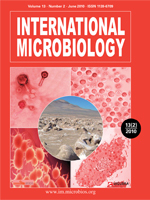The bacterial pan-genome: a new paradigm in microbiology (original) (raw)
Authors
- Alex Mira Department of Health and Genomics, Center for Advanced Research in Public Health (CSISP), Valencia, Spain
- Ana B. Martín-Cuadrado Evolutionary Genomics Group, Miguel Hernandez University, San Juan, Alicante, Spain
- Giuseppe D’Auria Joint Unit of Research in Genomics and Health, Centre for Public Health Research (CSISP) and Cavanilles Institute for Biodiversity and Evolutionary Biology, University of Valencia, Valencia, Spain. CIBER on Epidemiology and Public Health (CIBEResp)
- Francisco Rodríguez-Valera Evolutionary Genomics Group, Miguel Hernandez University, San Juan, Alicante, Spain
Keywords:
bacterial pan-genome, bacterial species, bacterial evolution
Abstract
Bacterial strains belonging to the same species vary considerably in gene content. Thus, the genetic repertoire of a given species (its “pan-genome”) is much larger than the gene content of individual strains. These variations in DNA material, together with differences in genomic structure and nucleotide polymorphisms among strains, confer upon prokaryotic species a phenomenal adaptability. Although the approach of sequencing multiple strains from a single species remains the main and often easiest way to study the pan-genome, feasible alternatives include those related to DNA hybridization. In other cases, the use of metagenomic sequences is already applicable by data mining from the growing metagenomic databases. Eventually, the single-cell genome approach might be the ideal solution. The pan-genome concept has important consequences for the way we understand bacterial evolution, adaptation, and population structure, as well as for more applied issues such as vaccine design or the identification of virulence genes. [Int Microbiol 2010; 13(2):45-57]
Author Biographies
Alex Mira, Department of Health and Genomics, Center for Advanced Research in Public Health (CSISP), Valencia, Spain
Department of Health and Genomics, Center for Advanced Research in Public Health (CSISP), Valencia, Spain
Ana B. Martín-Cuadrado, Evolutionary Genomics Group, Miguel Hernandez University, San Juan, Alicante, Spain
Evolutionary Genomics Group, Miguel Hernandez University, San Juan, Alicante, Spain
Giuseppe D’Auria, Joint Unit of Research in Genomics and Health, Centre for Public Health Research (CSISP) and Cavanilles Institute for Biodiversity and Evolutionary Biology, University of Valencia, Valencia, Spain. CIBER on Epidemiology and Public Health (CIBEResp)
Joint Unit of Research in
Genomics and Health, Centre for Public Health Research (CSISP) and Cavanilles Institute for Biodiversity and
Evolutionary Biology, University of Valencia, Valencia, Spain. CIBER on Epidemiology and Public Health (CIBEResp).
Francisco Rodríguez-Valera, Evolutionary Genomics Group, Miguel Hernandez University, San Juan, Alicante, Spain
Evolutionary Genomics Group, Miguel Hernandez University, San Juan, Alicante, Spain
Issue
Section
Review Articles
License
Submission of a manuscript to International Microbiology implies: that the work described has not been published before, including publication in the World Wide Web (except in the form of an Abstract or as part of a published lecture, review, or thesis); that it is not under consideration for publication elsewhere; that all the coauthors have agreed to its publication. The corresponding author signs for and accepts responsability for releasing this material and will act on behalf of any and all coauthors regarding the editorial review and publication process.
If an article is accepted for publication in International Microbiology, the authors (or other copyright holder) must transfer to the journal the right–not exclusive–to reproduce and distribute the article including reprints, translations, photographic reproductions, microform, electronic form (offline, online) or any other reproductions of similar nature. Nevertheless, all article in International Microbiology will be available on the Internet to any reader at no cost. The journal allows users to freely download, copy, print, distribute, search, and link to the full text of any article, provided the authorship and source of the published article is cited. The copyright owner's consent does not include copying for new works, or resale. In these cases, the specific written permission of International Microbiology must first be obtained.
Authors are requested to create a link to the published article on the journal's website. The link must be accompanied by the following text: "The original publication is available on LINK at <http://www.im.microbios.org>. Please use the appropiate URL for the article in LINK. Articles disseminated via LINK are indexed, abstracted, and referenced by many abstracting and information services, bibliographic networks, subscription agencies, library networks, and consortia.
